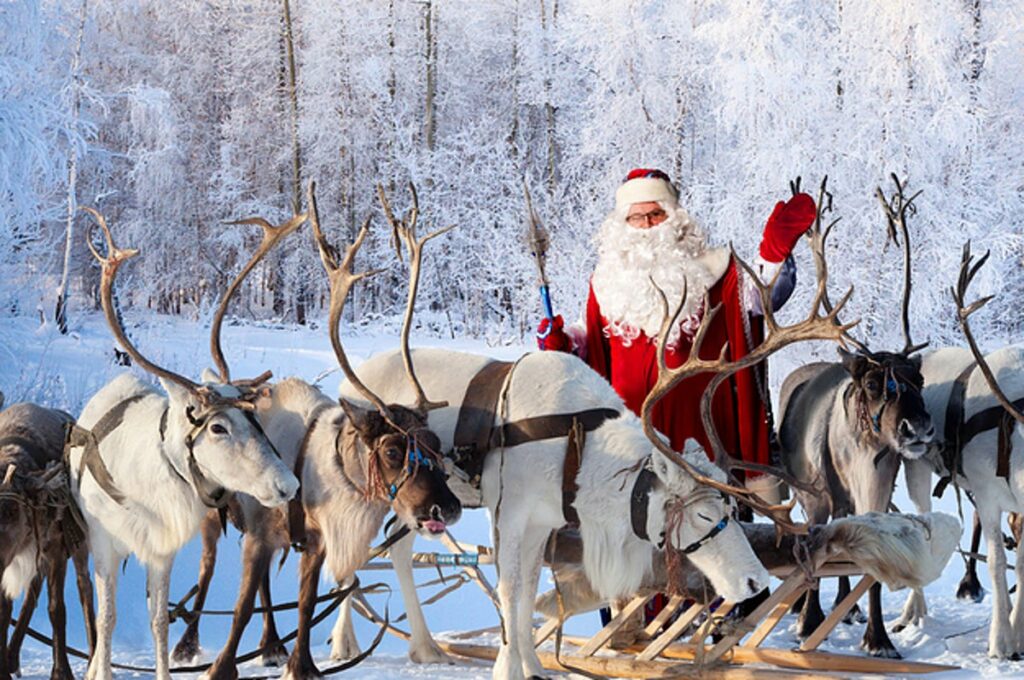
From the 1949 classic “Rudolph the Red-Nosed Reindeer” (bet you sung that in your mind), you most likely know the names of Santa’s reindeer, or at least some of them. But where did they come from, and are there eight or ten of them?
The origin of Santa’s reindeer
The “eight small reindeer” were mentioned in the 1823 poem “A Visit from Saint Nicholas,” often known as “Twas the Night Before Christmas” by Clement Clarke Moore:
“Dasher, immediately!” Dance now! Prancer and Vixen next!
Comet, come! It’s Cupid! On Blixem and Donder!
Children in the erstwhile New Amsterdam began referring to Santa as “Sante Klaas” in the late eighteenth century. “Sinter Niklaas” is a Dutch name for St. Nicholas that still serves as the foundation for his name today. Donder and Blitzen are both Dutch names derived from the expression “donder en bliksem,” which translates to “thunder and lightning.” In nineteenth-century New York, the expression was a mild kind of profanity; nevertheless, it was also amended in 1844. Blixem was renamed to Blitzen by Moore because it rhymed more well with Vixen. Marks also altered “Donder” to “Donner” in the song “Rudolph the Red-Nosed Reindeer,” although it’s unclear whether he did it because the word sounded better or because he was aware that it was German.
We can infer that Santa’s other reindeer had names that rhymed and suited the iambic meter in order to give them distinctive titles to yell as they took off on his sleigh. For instance, Dasher and Dancer are metered and alliterative names that adhere to the custom of naming animals after characteristics. This is questionable because it’s also thought that the Norse thunder deity Thor served as inspiration, particularly because in mythology, he drove a wagon pulled by his two goats, Gnasher and Cracker, over the heavens.
However, the text makes no reference to Rudolph by name. Where did the most well-known reindeer originate? Actually, Rudolph doesn’t make an appearance in historical documents till the 20th century. Although Johnny Marks’ Rudolph song’s lyrics were inspired by the classic “Twas the Night Before Christmas,” the character’s real design was created by the Montgomery Ward marketing department in 1939. Robert May, an advertising executive for a Chicago department shop, used the moniker Rudolph for the first time to promote the holidays in a fairytale. Not until ten years later was this name turned into the popular song.
How many reindeer are there?
Up until Rudolph entered the picture in 1939, Santa had a total of 8 reindeer. But over time, poetic ambiguity led to the addition of a tenth name to Santa’s flock. Olive, “The Other Reindeer,” was inspired by a misinterpretation of the song’s lyrics about Rudolph the Red-Nosed Reindeer. Some people mistook “Olive, the other reindeer” for “All of the other reindeer,” and as a result, a new reindeer persona was created.
The personalities of Santa’s reindeer
Dasher
Dasher is one of Santa’s quickest reindeer and his name is derived from the German term “Dascher,” which in English means “purse maker,” thus Dasher can even sew!
Prancer
Prancer, a devoted reindeer, may frequently be seen prancing around the workplace with the elves. Prancer also has to maintain a good appearance since he never knows who he may run into next.
Vixen
Vixen enjoys putting on a fantastic performance and flaunting his magic skills. He likes to perform pranks on the other reindeer, which makes him a bit cheeky around them, but Santa adores magic tricks since they help him deliver presents on Christmas Eve.
Comet
Comet is the reindeer who all the kids look up to and he likes the attention! Comet is easygoing and loves to play ball games with the fawns. Additionally, he offers them some words of wisdom that encourage good behavior.
Cupid
The adoring reindeer known as Cupid frequently carries mistletoe. Make sure you set out mince pies on Christmas Eve since Cupid loves sweets and they’re her favorite! She also enjoys singing, to to the chagrin of the other reindeer!
Donner
Donner, whose name is derived from the Dutch word for thunder, is always recognized when he enters a room because of his powerful, resonant voice. Like Cupid, he enjoys singing, especially when performing duets with his twin Blitzen.
Blitzen
Blitzen, a speedy and jovial reindeer that takes its name from the Dutch term for “lightning,” is akin to a lightning bolt. He consequently always arrives on time!
Rudolph
Rudolph, Santa’s compass, joined the group after the original 8. Being a timid reindeer, he initially felt awful about himself and his red nose, which others used to tease him about. The only way Santa could have guided them through the icy circumstances was if he had recognized his shining bulb of a nose as a present. When he’s not working, he enjoys playing hide and seek with his pals. However, he has an edge over the other reindeer since he can shine a light in the dark to help him locate them.
Santa’s reindeer are female?
The media has consistently portrayed Santa’s reindeer as male, yet science shows that this is inaccurate. His reindeer are female, according to experts, because male reindeer lose their antlers in early December when mating season is through while female reindeer maintain theirs all winter. Given that Santa’s reindeer are represented as having antlers, it is only logical to assume that female reindeer pull the sleigh on Christmas Eve every year.